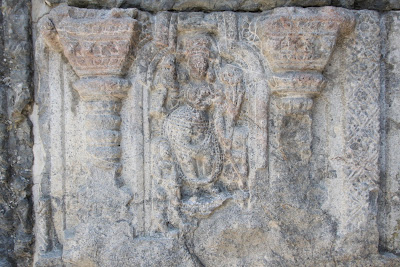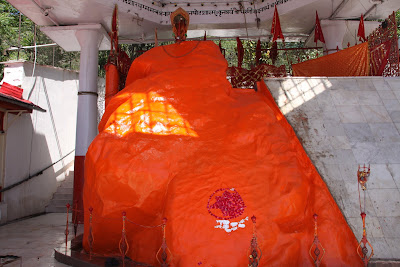Just one mile outside of Pahalgam, the gem of Kashmir in my opinion, crowned by the “children” of the Himalayas, is the fascinating, yet petite Mamaleshwar Temple, dedicated to Lord Shiva. According to Hindu tales, Ganesha, when he was still a young boy, was asked by his mother, Parvati, to stand guard while she bathed in a natural spring that still flows into a basin at the front of the temple today. She demanded that no one, under any circumstances, be granted entry until she had said so. Shiva, who had arrived in disguise, demanded entry, to which Ganesha defiantly denied him. Some would say the temple derives its name from this, ‘Mam mal’ meaning, ‘Don’t go.’ In anger, Shiva decapitated him, leaving Parvati in utter remorse and despair. To appease her, Shiva agreed to bring Ganesha back to life with the head of the first creature he saw, which of course, was an elephant. This is how Ganesha or Pillaiyar became the elephant-headed God in Hinduism. Of course, all Hindu tales, including this one, are symbolic of life’s grander lessons, which I won’t attempt to go into here. The landmarks of its stories, however, are marked by miraculous events and concentrated levels of energy derived from the faith and prayers of worshippers.
Mamaleshwar Temple houses a Lingam, for which rituals are still conducted by a pandit in the mornings and evenings. The temple also contains extremely old panels and sculptures depicting other deities. When I reached the temple, milk from the drip above was still pouring over the lingam, and unlike in most temples, devotees are permitted to enter the adhimoolam or the center of the temple and touch the statues during worship. The devotee in me was overwhelmed by this experience as I fought the urge to tightly hug the Lingam.
 Mamaleshwar Temple in Pahalgam
Mamaleshwar Temple in Pahalgam
 The Shiva Lingam within
The Shiva Lingam within
On route from Pahalgam to Srinagar, we stopped at two other sites of importance. The first was the Mattan Temple, dedicated to Lord Surya, the Sun. Alongside the original Surya temple and statue of the Sun depicted in human form, is a more recently constructed temple and statue. In front of the temples is a massive basin of crystal blue waters, crowded with catfish, considered to be holy by Muslims, Sikhs, and Hindus alike. This temple is not to be mistaken with the original Mattan temple in Martand, of which only ruins are left, though reminiscent of the skillful architecture of the time. It was built by King Lalitaditya of the Surya (Sun) dynasty, ostensibly in the 700s AD. Unfortunately, I missed seeing its stunning ruins this time around.
 Mattan Temple, dedicated to the Sun
Mattan Temple, dedicated to the Sun
 The Sun, depicted as Surya Man
The Sun, depicted as Surya Man
 The older Surya statue
The older Surya statue
 Small shrine in the basin, shivalingam enshrined
Small shrine in the basin, shivalingam enshrined
Even more spectacular were the ruins of the Avantisvamin temple, dedicated to Lord Vishnu, in Avantipur, constructed by King Avantivarman of the Utpala dynasty in 853 AD. It is widely believed that this site was a sacred center even before the construction of the temple here. The king had constructed several temples in the region, Avantiswara, dedicated to Lord Shiva, being another renowned one just down the road from the Avantisvamin temple. The temples were constructed in very similar styles, resembling courtyards enclosed by arches and columns, 69 to be exact, with varied forms of the deity enshrined within each. At the center of the “courtyard” is the main shrine, built on a double base with four subsidiary shrines at the corners. Reliefs and panels have been sculpted into the stairwells, sidewalls, and rails, ornamenting the entire temple grounds. Sadly, very little of the superstructure or adhimoolam remains, however, the central shrine once contained a four-armed Vishnu, its whereabouts unknown to me. Other prominent figures include those of the holy rivers, Yamuna and Ganga with their respective vahanas, the king and queen with their attendants, Kamadeva with his consorts, and Ardhanarisvara (!). While some sculptures are preserved in the S.P.S. museum in Srinagar, many, inconsolably, were lost during the pillaging and destruction during foreign invasion.
 Sculpture of Ganga in human form
Sculpture of Ganga in human form
 The ruins of the temple and the main shrine at the center
The ruins of the temple and the main shrine at the center
 2 of the 69 arched cells in which statues of the deity once were enshrined
2 of the 69 arched cells in which statues of the deity once were enshrined
 Kamadeva with his consorts
Kamadeva with his consorts
 Apsaras, female demigods, carved into the stairwells
Apsaras, female demigods, carved into the stairwells
 The columns and broken archways of the temple, very similar to Greek architecture
The columns and broken archways of the temple, very similar to Greek architecture
 Base of broken columns, again simiar to Greek architecture
Base of broken columns, again simiar to Greek architecture
 Sculpted railings
Sculpted railings
 Structural supports, resembling rectangular lingams
Structural supports, resembling rectangular lingams
Upon arrival in Srinagar and after another delicious, mouthwatering Kashmiri lunch, my appetite for immersing amidst these ancient sites was not yet satiated. We moved on to the next shrine at Hari Parbat. After a drawn out questioning by the army, who guard all major Hindu sites, I finally made my way up a remaining set of stairs to the shrine. It is believed that the Goddess Sharika, an 18-armed form of the Goddess Shakthi or the Divine Mother, manifested herself in the form of a Shilla (natural rock formation). The Chakreshwar shrine was built to enclose the Shilla for preservation and worship. The large, orange formation depicts the back of the Goddess, seated on a lion. On her back is believed to be a natural protrusion in the shape of the Sri Chakra Yantra. If you know me well, well then you can imagine by excitement to see this symbol here and all over the walls of the shrine! It is, by far, the symbol of Hinduism that resonates most deeply with me and captures the essence of existence cosmically, mathematically, and philosophically. The ‘Sri Yantra,’ as it is commonly referred to by Hindus, is composed of circles and lotus petals and contains nine independent triangles mystically drawn, one within the other. The four triangles pointed upwards represent Shiva (the male force), while the other five triangles pointed downwards represent Shakthi (the female force). The intersecting triangles represent the play of creation, protection, and absorption of the whole universe by the pure divine force known as Sudha Shakthi. The central point in the chakra is the Bindhu, which symbolizes the union of Shiva with Shakthi. It is one of the most densely meaningful, yet concurrently, most simplistically designed symbol that captures it “all”.
 Entrance to the Chakreshwar Shrine
Entrance to the Chakreshwar Shrine
 The enshrined Sharika Shilla
The enshrined Sharika Shilla
 The Sharika Shilla
The Sharika Shilla
The last place I could visit before closing times was the Shankaracharya Temple, overlooking Kashmir Valley and the Dal Lake. This petite temple is believed to have been originally constructed as early as the 5th century BC by the Pandavas themselves and is situated at the very top of the Gopadari Hill, now known as the Takht-e-Suleiman. The temple, before Shankaracharya’s visit, was known as the Jyesteshwara Temple and is dedicated to Lord Shiva. It, too, contains a Lingam, which can be touched by worshippers, and is considered to be the oldest shrine in the Kashmir Valley. Here, too, I felt significantly humbled and emotionally overwhelmed to be literally rubbing shoulders with the divine and with history. The top of the temple provides one of the grandest panoramic views of the entire valley. Most of the sites did not allow photography, and I was left with the option of purchasing postcards and photos of the shrines and the deities within, which I will hopefully scan and upload here soon.
 Hazy view of the Shankaracharya Temple
Hazy view of the Shankaracharya Temple
 Photo from http://www.rainbowskill.com/ of the Shankaracharya Temple
Photo from http://www.rainbowskill.com/ of the Shankaracharya TempleIn the meantime, those interested can visit the many websites describing the many wonders of the ancient Hindu world of Kashmir. One I referred to while there was http://ikashmir.net/temples/index.html, which also describes some of the holiest pilgrimage sites of the religion, including Kheer Bhawani, dedicated to the Goddess, whose waters turn black during significant events of turmoil in the world, the Amarnath Caves, believed to be 5,000 years old, in which an ice stalagmite resembling the Shiva Lingam rises and falls with the phases of the moon, and the Mata Vaishno Devi shrine, where statues depicting the three primary forms of the Goddess, Durga, Laxmi, and Saraswati, are worshipped. Kashmir is a gem and a wonder I can’t wait to return to and continue exploring.








No comments:
Post a Comment